FEBRUARY 2009: India’s first unmanned moon mission from Sriharikota (Nellore district in Andhra Pradesh) with orbiting spacecraft Chandrayaan-1 (moon craft) taking the moon impact probe (MIP) has been launched successfully. The MIP having Indian tricolour painted on all its sides landed on the moon surface after having flown 386,000 km from the earth, making India the fourth country on the earth to land a probe on the moon. Indian scientists involved in particular and all the public in general are very proud of this scientific and technological endeavor.
According to Dr G. Madhavan Nair, chief of Indian Space Research Organisation (ISRO), “We have given moon to India.” Every concerned Indian has traveled all the way to the moon virtually along the MIP. The MIP has already sent images with high resolution of the moon for analysis.

The United States, the former Soviet Union and the European Space Agency comprising 17 countries already have their flags on the moon and Chandrayaan-1 is the world’s 68th mission. Chandrayaan-1 was assembled to have eleven payloads. The spacecraft being readied at another building was moved
to the vehicle building to couple Chandrayaan-1 with the launch vehicle and with all the payloads it was then moved to the launch pad. The successful flight of MIP is supposed to prepare for the second
Indian moon mission, Chandrayaan-2, which will carry a Russian rover and a lander slated for lift-off between 2010 and 2012.
Let’s review Chandrayaan’s journey, payloads and mission objectives.
Space probe
A space probe is a scientific space exploration mission in which a robotic spacecraft leaves the gravity well of the earth and approaches the moon or enters interplanetary or interstellar space; approximately twenty are currently existant. The space agencies of the USSR (now Russia and Ukraine), the United States, the European Union, Japan and China have in the aggregate launched probes to several planets and moons of the solar system as well as to a number of asteroids and comets.
A space probe destined for a planet or other astronomical body can be classified as a ‘flyby,’ ‘impactor,’ ‘orbiter’ or ‘lander’ mission. Historically, flyby missions proved easiest to accomplish, as these did not require the precise navigation needed for an impact, nor the additional propulsion to conduct a manoeuvre to enter the orbit. Upon landing some landers have released ‘rovers,’ which travel across the surface of the astronomical body upon which they have landed.
Once a probe has left the vicinity of the earth, its trajectory is likely to take it along an orbit around the sun similar to the earth’s orbit. To reach another planet, the conceptually simplest means is to execute a Hohmann transfer orbit manoeuvre.
More complex techniques, such as gravitational slingshots, can be more efficient, though these may require the probe to spend more time in transit. A technique using very little propulsion, but possibly requiring a considerable amount of time, is to follow a trajectory on the interplanetary transport network.

Launch vehicle journey
The polar satellite launch vehicle, usually known by its abbreviation ‘PSLV,’ is an expendable launch system operated by the Indian Space Research Organisation (ISRO). It was developed to allow India to launch its Indian remote sensing (IRS) satellites into sun synchronous orbits—a service that was, until the advent of the PSLV, commercially viable only from Russia. PSLV can also launch small-size satellites into the geostationary transfer orbit. The reliability and versatility of the PSLV is proven by the fact that it has launched 30 spacecrafts (14 Indian and 16 from other countries) into a variety of orbits so far. In April 2008, it successfully launched ten satellites in one go, breaking the world record held by Russia.








